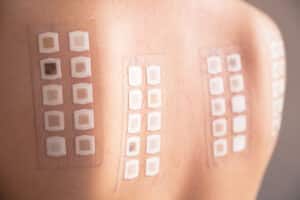
What Is Skin Allergy Testing?
Skin allergy testing is a reliable and noninvasive method of diagnosing allergic contact dermatitis. Otherwise known as the “patch test,” the process requires a patient to wear adhesive panels, typically on the back, for two days.
It’s important not to remove the panels or get them wet without first consulting a medical provider. It’s also important to show up for the 2-day second visit with your provider so they can determine your allergens properly.
Which Allergens Are Commonly Tested?
During your skin allergy testing, your provider will test your skin for a reaction to 35 different common skin allergens. These are substances that frequently cause contact dermatitis in patients with skin allergies. They include (but are not limited to):
- Nickel sulfate
- Latex
- Wool alcohols
- Fragrance mix
- Paraben mix
- Epoxy resin
- Black rubber mix
- Formaldehyde
- Hydrocortisone-17-Butyrate
- Gold sodium thiosulfate
- Balsam of Peru
- (and 25 more, plus a negative control area)
Are There Side Effects of Skin Allergy Testing?
Minor side effects, like swollen, red, or itchy skin under your testing panels, are common. This is how your medical provider will determine the existence of a skin allergy.
Severe side effects, such as nausea, vomiting, difficulty breathing, and anaphylaxis, are rare. After your panels are placed, you will stay at the provider’s office for a short amount of time to ensure that your reaction is not likely to be severe. If you show signs of a severe reaction, patch testing will immediately conclude.
Does Skin Allergy Testing Hurt?
While you may experience itching, burning, swelling, tenderness, and blistering if you have a skin allergy to any of the tested substances, you should not feel pain. Most patients describe patch testing as uncomfortable at first but not painful. Your medical provider can determine if patch testing is the right course of action for you.
Address Skin Allergy Issues in Southern California
Your skin allergies don’t have to be a mystery. To learn more about skin allergy testing, contact the Skin & Beauty Center by phone at (818) 842-8000 or online anytime.
